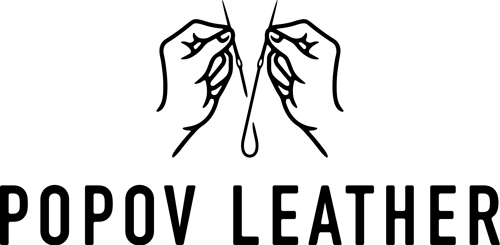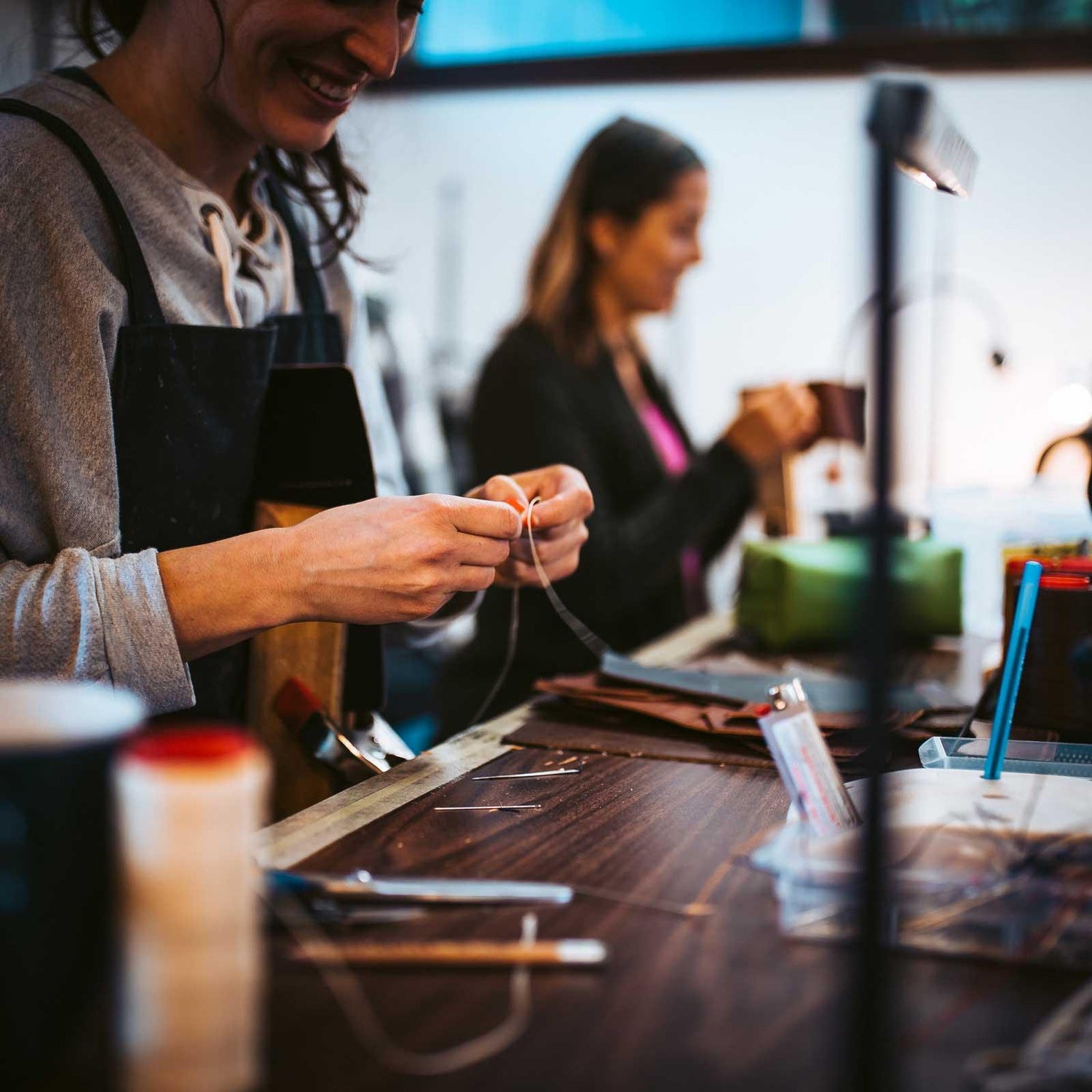What benefits come from sewing leather by hand and why do most companies prefer using sewing machines?
Ever since I started Popov Leather, I've been all about sewing our goods by hand. And there are 2 very important reasons why:
- The superior strength and durability
- The beautiful look
This won't be a post about me being harsh on machine-sewn leather goods. They have a place and it's wholly dependent on what the customer ultimately wants. Whether it's the speed of production, cost of the final product, or a lifetime of use.
Okay, maybe that was a little passive-aggressive. But let's dive in and see the differences.
Table of Contents
Machine Sewn Leather Goods
What's a lock stitch?
Hand Sewing Leather Goods
What is saddle stitching?
What are the differences in strength between hand sewing and machine sewing leather goods?
Differences in Aesthetics
The Look of Machine Sewn Leather
The Look of Hand Sewn Leather
Visual Characteristics
The Look of Machine Sewn VS Hand Sewn
The Hole Sizes on Hand Sewn VS Machine Sewn Goods
The Size (and Quality) of the Thread and the Spacing of the Stitches
Different Threads Used for Sewing Leather
Linen Thread
Nylon Thread
Polyester Thread
Why Popov Leather Sews By Hand
Machine Sewn Leather Goods

Machine sewing leather isn’t bad.
Or at least, it doesn’t have to be. In fact, machine sewing has one big advantage over hand sewing, and that’s speed. Therefore, machine sewing tends to be the default when it comes to manufacturing leather goods.
Ultimately it comes down to the compromises that each company is willing to make in producing their product.
With machine sewing, the company is almost always choosing to sacrifice some form of quality for the sake of speed.
Very often, thinner or cheaper threads will be used, which can lead to a less durable product. Even when a high-quality thread is chosen, machine sewing relies on what’s known as a lockstitch.
What's a Lock Stitch?
A lockstitch is a stitch made with a sewing machine that involves the interlocking of the upper (needle) thread with the lower (bobbin) thread.
To illustrate this further, imagine the needle on the sewing machine popping through the leather. Each time it emerges, it creates a little loop that another thread is pulled through.
When the needle retracts and moves on to the next stitch, that loop is cinched tightly somewhere between the layers of material.
Machine sewing is also used by many smaller craft leather shops as well.
This is more common with larger leather goods, such as bags, but some machine-sew smaller items such as wallets as well.
When the amount of orders you can fill is limited by the number of hands you have available, you either choose a faster method or you do what we did and hire more hands.
Machines are going to be able to do certain repetitive tasks more quickly than any person.
If your primary concern is quality, however, then what matters isn’t so much how fast the sewing is done, but rather the way in which it’s done.
Hand Sewing Leather Goods
While sewing machines excel in speed, they lack the manual dexterity of a craftsman with a pair of needles.
What is saddle stitching?
Saddle stitching is a form of hand-sewing where both ends of a length of thread are passed through each stitch hole, crisscrossing back and forth along the entire length of the sewn piece.
The term “saddle stitching” originated from the saddle makers who employed the technique, though the origins of the technique likely go back much further.
These saddlers needed a way to sew together thick pieces of leather. After all, saddles must be able to take a tremendous amount of wear. The last thing you need when you’re riding high on a 1,200-pound creature is for a flimsy stitch to pop in the wrong place.
For much of the history of saddlery, there were no sewing machines.
Despite a century of experimentation starting in the mid-1700s, the first commercially viable sewing machine didn’t emerge until 1834.
To this day the very best saddles are still hand sewn.
Hand sewing sacrifices speed for the sake of quality. It is time-consuming, and that’s part of its charm.
Each time you pick up a hand-sewn piece of leather, you’re witnessing something of the person who made it. Yet it’s about more than simply clinging to traditions. There are tangible benefits to hand-sewing leather—and aesthetic ones as well.
That’s exactly why we continue to hand-sew our products.
All these elements—the techniques, the materials, and of course the skill of the craftsman— all work together to provide a superior stitch.
And just consider, if saddle-stitching is good enough for an actual saddle, think of what it can do for a wallet.
What are the differences in strength between hand sewing and machine sewing leather goods?
Hand-sewing (saddle-stitching in particular) provides the greatest strength and security when it comes to stitching materials together.
Imagine a line sewn with red and green thread, one on either side. Because of how saddle-stitching works, you would see the colors alternating along both sides of the leather (red, green, red, green, etc.) This is where the durability comes in. Even if one of those threads were to break, the remaining thread would continue to hold.
Meanwhile, machine-sewing doesn’t have this sort of backup.

Let’s take another red and green thread as in the example above.
What would we expect to see with machine sewing? Rather than the alternating colors of the saddle stitch, you would instead see a red side and a green side.
This may sound secure at first glance, but wait— suppose one of those threads breaks. What then?
The first thing is that those little loops adjacent to the breaking point will start to unravel. Remember, there’s no backup thread here like with the saddle-stitch. Once one loop breaks, it’s only a matter of time before the whole thing starts coming apart.

Differences in Aesthetics
This may sound obvious, but part of the appeal of hand sewn leather is that it was done by a real person.
Of course, sewing machines are operated by real people as well and I wouldn’t deny their skill, but the rhythms of the work and the care that goes into it are very different.
Whereas the machine’s foot noisily stomps its way across the surface of the leather, the craftsman takes great care with every stitch, responding to the subtle variations in the leather. It’s a meditative act in a world that no longer values such things.
And the results speak for themselves.
It would be difficult to find anyone who would argue that machine stitching has greater aesthetic appeal than a quality stitch done by a skilled craftsman.
The Look of Machine Sewn Leather
When we say that something is machine-like, we typically mean that it’s robotic, predictable— routine.
A machine-sewn piece is no different.
It plods along from stitch to stitch with precisely spaced intervals. It may do its job well enough, but it generally doesn’t draw the eye, and it’s not meant to.
In fact, machine stitching is often merely functional. If it calls attention to itself at all, it’s usually through conventional means such as a contrasting color, but rarely if ever for the quality of the stitch itself.
When was the last time you stopped to admire a machine sewn edge?
Machine-sewn leather wallet on the left, hand-sewn leather wallet on the right.
The Look of Hand Sewn Leather
Hand-sewn leather meanwhile has something that machine-sewn leather simply doesn’t.
Character.
The character of a hand-sewn piece of leather comes from the craftsman who stitch by stitch creates an appealing overlap between the threads. In fact, it’s one of the things which sets hand sewing apart.
A hand-sewn edge is a piece of functional art.
It doesn’t simply convey function. It also speaks to the aptitude of a craftsman who has worked hard through thousands upon thousands of stitches in order to hone a particular skill.
As humans, there’s something about that which speaks to us more clearly and more profoundly than exacting efficiency and speed ever could.
Visual Characteristics
The Look of Machine Sewn VS Hand Sewn
Machine-sewn items tend to have a straight stitch that continues along its path with little to no variation. Hand Sewn leather meanwhile will often have that pleasant overlap we mentioned earlier. It creates diagonals along the sewn edge. This comes from a subtle twist that is introduced when one thread overlaps the other as they move from stitch to stitch.
Of course, this can vary depending on the specific techniques and tools used to create the holes, which ties in nicely with the next point.
Machine-sewn leather wallet on the left, hand-sewn leather wallet on the right.
The Hole Sizes on Hand Sewn VS Machine Sewn Goods
Hand sewn leather tends to have great variety in the sizes, shapes, and angles of the stitching holes, while machine sewn pieces tend to have little to no variation. What you’ll often see are simply small round holes, created from the needle piercing the leather.

The most traditional tool for hand sewing leather is an awl, which creates a diamond-shaped hole.
Also common are pricking irons which can add several holes at a time with a single tap of the mallet. These come in a variety of sizes and styles. Some have a flat row of teeth and others are more diagonal.
In either case, they tend to produce narrow slits in the leather. You can get a still different—and rounder—look with something like the Korean-made Sinabroks hole punches (which is what we use).
It’s not that any of these are generally better than any other. It comes down to the aesthetic preferences of the craftsman and the needs of the piece being made. If for instance, you’re going to use a thicker thread, either for strength or a more robust aesthetic, you might benefit from having larger holes.
The Size (and Quality) of the Thread and the Spacing of the Stitches
Machine stitched pieces often use thinner (or at least cheaper) thread. Where speed is a concern, cost often is as well. Good thread can be expensive. And let’s be honest, many manufacturers likely don’t have longevity in mind when choosing materials.
Many machine-sewn pieces also often have a greater number of stitches per inch. Traditionally in hand sewing, the more stitches a piece had, the more refined it was. More stitches, however, also mean more time spent sewing a piece. Since the number of stitches has virtually no bearing on the speed of production, machine-sewn pieces will attempt to mimic this look in much the same way that faux-Italian styles ape the real thing.
Different Threads Used for Sewing Leather
While sewing technique is a major factor in terms of the strength of a piece, a stitch is only as good as the thread which holds the material together. Even a great saddle stitch can be undermined by a poor-quality thread.
Threads can be broken down into two types, natural (or organic) and synthetic. Each has its own advantages and drawbacks which can be measured by a variety of factors. These include the overall tensile strength of the thread (including its strength relative to the thickness of the material), its elasticity, environmental durability (such as with exposure to heat, water, and sunlight), available colors, and so on.
Some of the more common thread types used for leatherworking are linen, nylon, and polyester. Others include cotton, sinew (whether real or synthetic), and even Kevlar threads (which are used in special cases requiring high heat resistance).
Let’s take a closer look at each of the three common threads.
Linen Thread
Linen thread comes from flax. It has several benefits that make it one of the standard threads for many craftsmen. Linen thread is typically coated with beeswax and provides high durability (though it’s not the strongest option). Since it has next to no stretch, it tends to hold a tight stitch over time. It also has the unique property of being stronger when wet, due to its fibers swelling.
Linen is primarily, though not exclusively, used for hand-sewing.
Nylon Thread
Nylon thread is arguably the most widely used. Its strong relative to its thickness has reasonable UV (ultraviolet) resistance, and being a synthetic material, comes in a broad variety of colors which wouldn’t be possible with traditional dyeing.
Also, due to the nature of the material, it’s not prone to fraying in the same way that natural threads such as cotton or linen might be. On the flip side, Nylon is prone to stretching over time (up to 28%), which may lead to a less secure stitch and a weakened thread.
Ultimately, however, Nylon is chosen for many applications for one reason in particular—it’s less expensive than the alternatives. In that regard, it’s a middle-of-the-road option that has many good qualities, but very few outstanding ones.

Polyester Thread
Polyester meanwhile is the thread when it comes to overall durability for sewing leather. It has most of the benefits of Nylon, and virtually none of the drawbacks (aside from being more expensive). Not only does it have high tensile strength, but it also has excellent UV, moisture, and mildew resistance—which is to say that it’s one of the more durable threads around and ideal for any leather items that will see heavy use.
It’s common to find polyester thread used for both machine and hand sewing. And, even though polyester is synthetic, it creates beautiful stitching with a natural look.
Why Popov Leather Sews By Hand
Each of our pieces is hand sewn using Ritza 25 Tiger thread—a German import.
It’s a 100% polyester braided thread, which is flattened and lightly waxed, making it extremely strong and ideal for hand-sewing. Many leather workers consider it to be the best thread in the world.
And in our experience its reputation is well-earned.

We don’t take shortcuts when it comes to quality. We want each piece that leaves the workshop to stand as a testament that craftsmanship is alive and well. While the rest of the world insists on “faster” and “cheaper”, we think in terms of “better” and “stronger”.
Every choice we make is done with the intention of producing the best work possible. This includes our decision to sew by hand, our choices in the thread, and the belief that newer doesn’t always mean better.
You can get good work with machine stitching.
The best work however requires something more patient—more deliberate.
That’s exactly why we give our work a more hands-on approach.
Written by Ryan Popoff
Ryan Popoff is the creative mind behind Popov Leather wallets, iPhone cases, belts, watch bands and journals since 2013. With a Bachelor Degree in Fine Arts, my leatherworking journey began at home. I wanted to create a simple leather wallet that could fit into my front pocket and — to my delight — it was a hit with family and friends. Hopefully you love our honest, quality leather goods too! Reach out with questions.












